How to Cook Perfect Farro on the Stove
on Jun 07, 2019, Updated Jun 23, 2025
This post may contain affiliate links. Please read our disclosure policy.
Learn how to cook farro on the stovetop with the perfect water ratio and timing. Easy step-by-step instructions for tender, chewy farro every time.
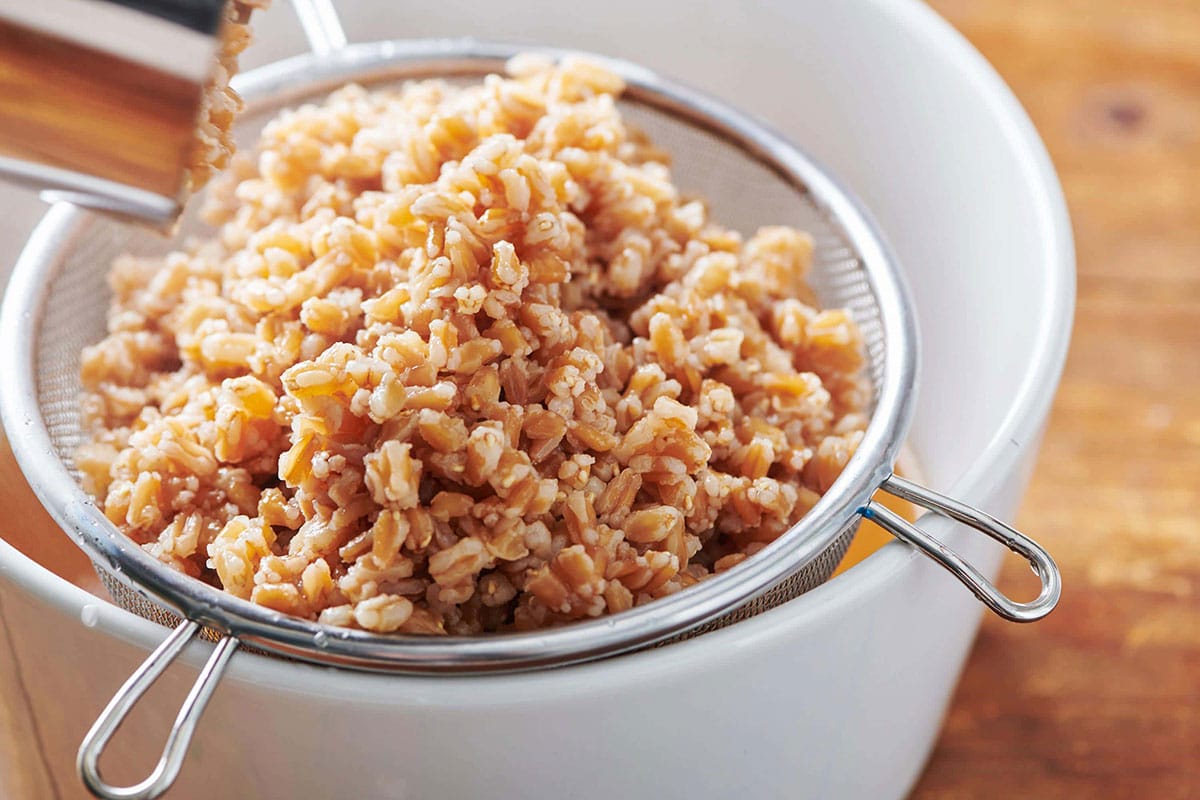
Farro is a hearty, nutty whole grain that’s as nutritious as it is versatile — and cooking it on the stovetop couldn’t be easier. Whether you’re new to cooking farro or just looking for the best way to get that perfect chewy texture, this simple method will walk you through exactly how to do it.
All you need is water, salt, and a pot. In about 30 minutes, you’ll have tender, flavorful farro ready to use in salads, grain bowls, soups, or as a wholesome side dish. Learn the right water-to-farro ratio, how to know when it’s done, and tips for storing and reheating.
By signing up, you agree to our Privacy Policy.
Once you have your cooked farro, try Farro and Vegetable Salad, Farro with Grilled Broccoli and Sweet Onions, or Tomato and Farro Salad.
What's In This Post?
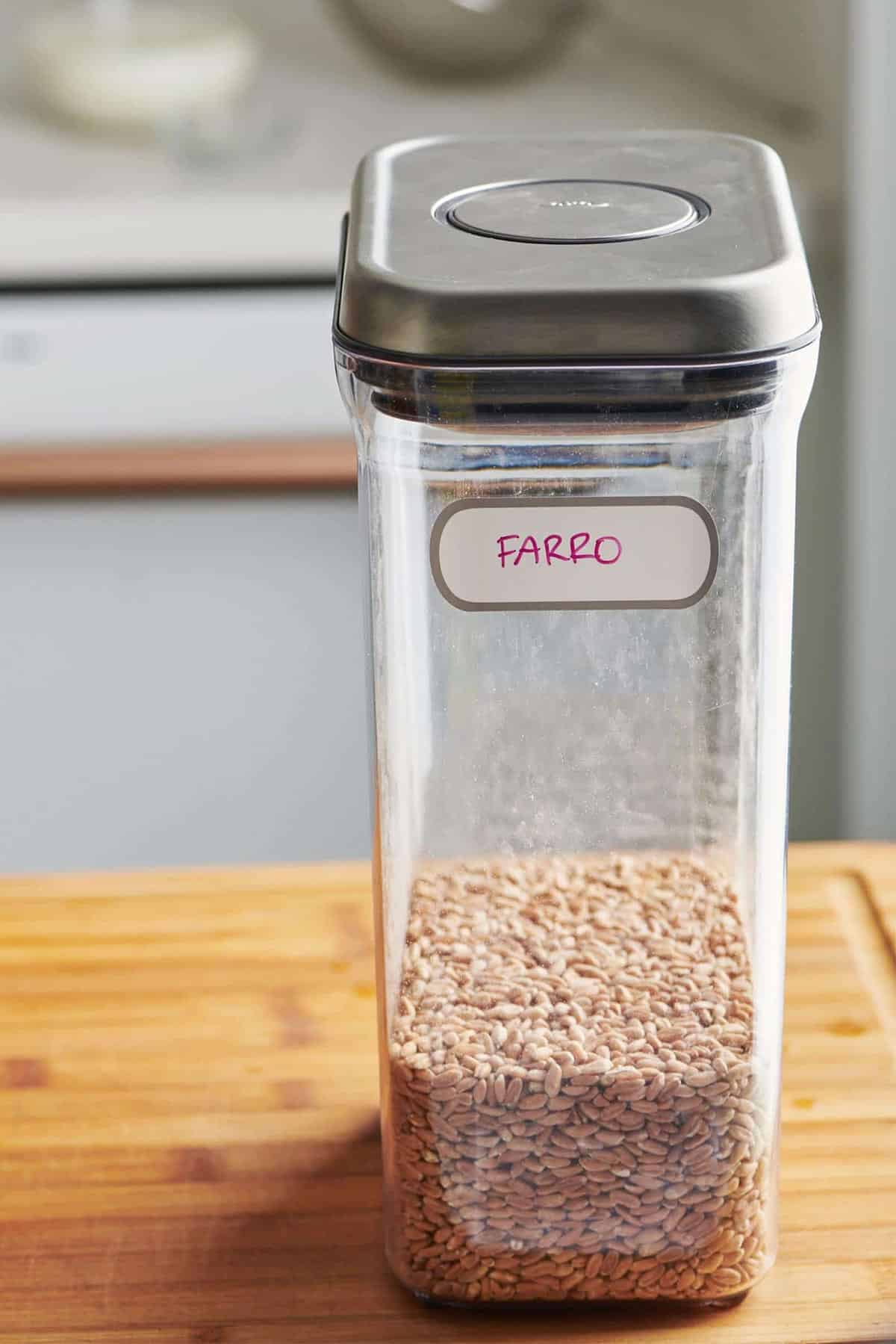
A Secret to Perfect Farro
I like cooking farro in a diluted broth, allowing it to simmer and absorb flavor, then draining off any excess liquid. This also means you don’t have to worry about the grains absorbing the liquid too quickly and the grains drying out or, worse, burning on the bottom of the pot.
How Long Does Farro Take to Cook?
Whether you’re cooking pearled, semi-pearled, or whole farro, this guide will walk you through the best cooking method and water ratios for perfect results every time. Farro can take anywhere from 25 to 40 minutes on the stove to become tender. The cooking time depends on the type of farro itself, the age of the grain, how deep or shallow your pot is, and if other ingredients have been added to the pot.
Pearled farro cooks the fastest, in about 15 to 20 minutes. Semi-pearled farro takes around 25 to 30 minutes. Whole farro can take up to 45 minutes. (The longer the cooking time, the more helpful soaking the farro is to reduce the cooking time.)
Luckily, farro keeps its texture without getting mushy, even if it has extra time on the stove. The key is making sure that the liquid doesn’t evaporate, as then the bottom grains will start to brown and burn.
How Long To Soak Farro?
While it is not necessary to soak farro before cooking, it can reduce the cooking time, so if you plan ahead, you’ll be rewarded with faster results.
Pearled Farro:
- Usually does not require soaking because the outer husk is mostly removed, allowing for quicker cooking, about 20 minutes.
- If you want, soak pearled farro for 30 to 60 minutes to shorten the cooking time slightly (about 15 minutes instead of 20 or so).
Semi-Pearled Farro:
- Has some of the brain left on, so it benefits from soaking.
- Soak for 1 to 2 hours before cooking. This will shorten the cooking time from 25 to 20 minutes to about 20 minutes.
Whole Farro:
- The outer husk is intact, making it the chewiest type of farro and the longest to cook.
- Soak for 8 hours or overnight in plenty of water to cover the grains by at least a few inches. This not only shortens the cooking time from about 45 minutes to about 30 minutes. It also helps with digestibility.
Farro to Water Ratio
For the best results, keep in mind that 1 cup of farro will take 3 cups of water or broth (or a combo of the two liquids) to cook.
| Farro | Water or Broth |
|---|---|
| ½ cup | 1 ½ cups |
| 1 cup | 3 cups |
| 1 1/2 cups | 4 1/2 cups |
| 2 cups | 6 cups |
Stovetop Farro Cooking Instructions
- Prepare the farro: Rinse and drain the farro.
Kitchen Smarts
Whether you have soaked the farro or not, you can toast the farro first in a dry pot over medium heat, stirring frequently, for a few minutes to give it an even nuttier flavor before proceeding with the simmering instructions below.

- Combine farro and liquid: Place the drained farro into a pot. Add 3 cups broth or water (or a combo).
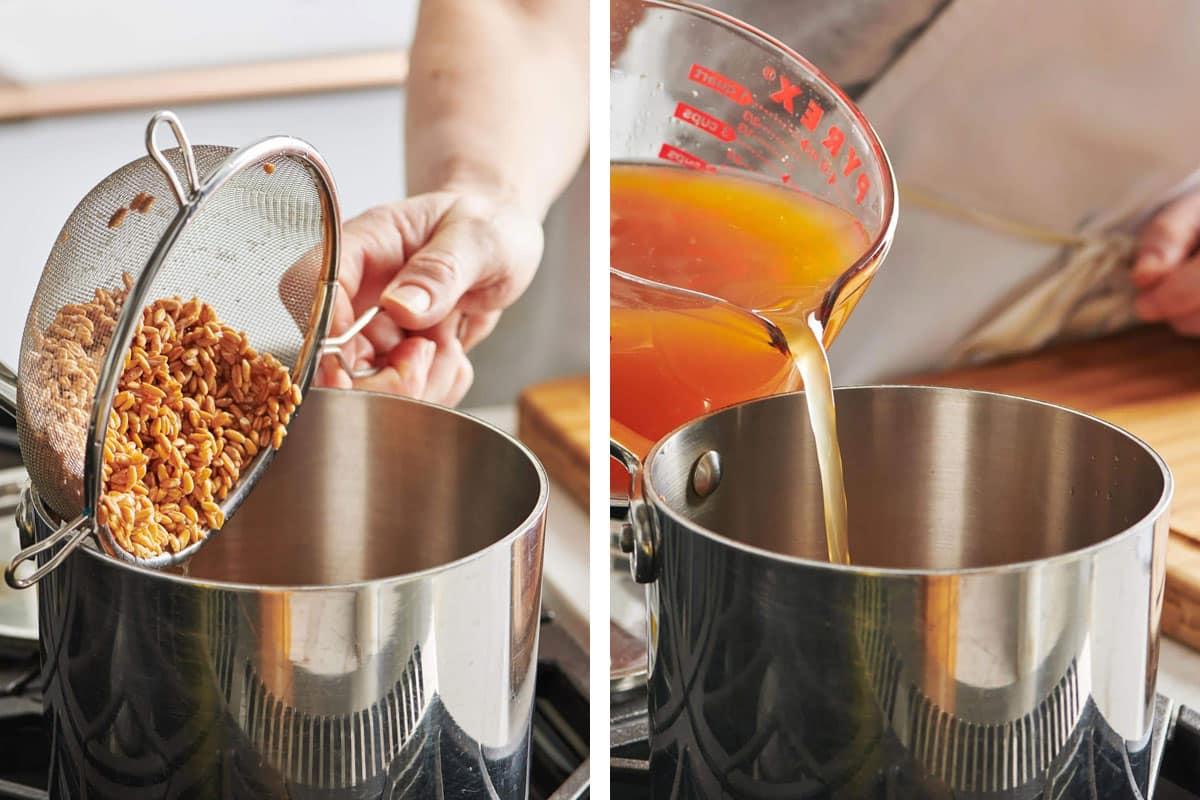
- Cook the farro: Season with salt and add a bit of olive oil or butter if desired. Simmer, covered, for about 30 minutes. Drain off any excess liquid once the grains are cooked to the level of tenderness you like.
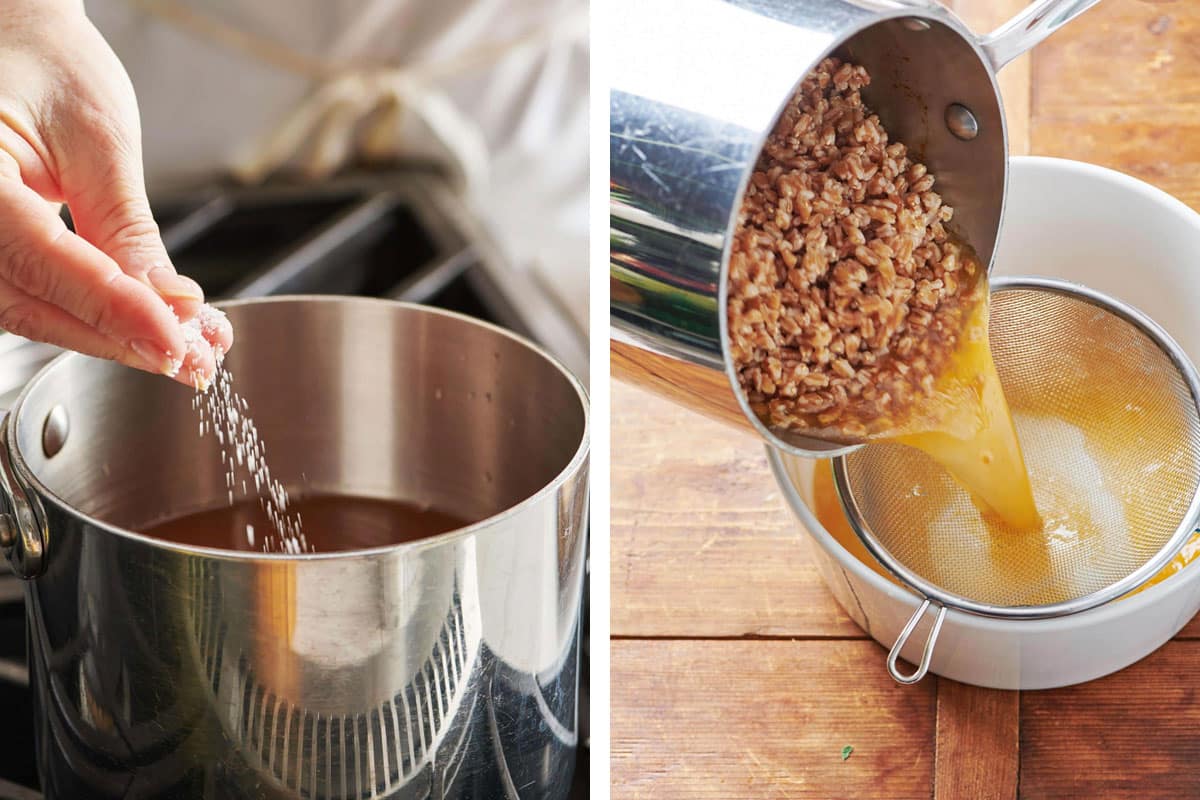
How To Use Farro
You can add cooked farro to soups and stews, as well as salads. It might be the starring ingredient in a grain salad, or a handful of cooked farro makes a very interesting addition to lettuce or vegetable-based salads.
Because it’s a dense grain, if it is the main ingredient, you will want to add a substantial amount of other ingredients so that the grain salad doesn’t feel too heavy.
Recipes With Farro
Pin this now to find it later
Pin It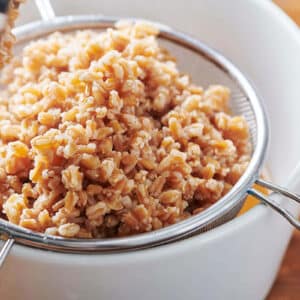
How to Cook Perfect Farro on the Stove
Ingredients
- 1 cup farro
- 3 cups water (or stock or a mixture of both)
- ½ teaspoon Kosher salt
- 1 teaspoon butter or olive oil (optional)
Instructions
- Place the farro into a mesh sieve and rinse with cold water. Drain.
- Place the farro into a medium-sized pot with a lid. Add the water or stock or a combination of both, and add the salt and butter or olive oil if using. Bring to a boil over high heat.
- Reduce the heat to low, cover, and gently simmer for about 30 minutes, until it is tender but still chewy (if you have soaked it overnight, the cooking time will be shorter). The cooking time depends on a number of factors, all explained above! If there is liquid remaining in the pot, drain it in a sieve.
- If you are using it in a salad or a room-temperature dish, spread it out on a rimmed baking sheet to cool to prevent it from getting mushy.
Notes
Farro Cooking Tips
- Rinse and drain your farro before cooking.
- You can toast the farro first in a dry pot over medium heat, stirring frequently, for a few minutes to give it an even nuttier flavor before proceeding with the simmering instructions below.
- Soaking farro can shorten the cooking time, but it’s not necessary.
- Use a combo of half water and half chicken or vegetable broth to give your farro an extra bump of flavor.
- Farro is not gluten-free, so people with gluten intolerance or celiac disease should not eat it.
Nutrition
What You Need to Know About Farro
Farro is a super ancient grain, possibly the oldest grain in the world. It originated in Western Asia and has been extremely popular of late with the resurgence of interest in whole grains. It is similar to barley but denser and chewier.
There are three different kinds of farro:
– Piccolo (einkorn, triticum monococcum)
– Medio (emmer, triticum dicoccum)
– Grande (spelt, or tritucum spelta)
Farro is also available with different amounts of the bran intact or removed.
One cup of dried farro will make about 2 to 2 1/2 cups of cooked farro.
Farro is nutritious and high in protein, fiber (the more bran, the more fiber), iron, magnesium, and B vitamins. It has almost no fat, and it’s cholesterol-free.
No, according to BeyondCeliac.org, farro is a type of wheat that contains gluten. People with gluten intolerance or celiac disease should not eat farro.
Farro is available packaged (Bob’s Red Mill brand is often the one stores carry), or it may be in the bulk foods aisle of well-stocked supermarkets and natural foods stores. Or you can buy farro online.
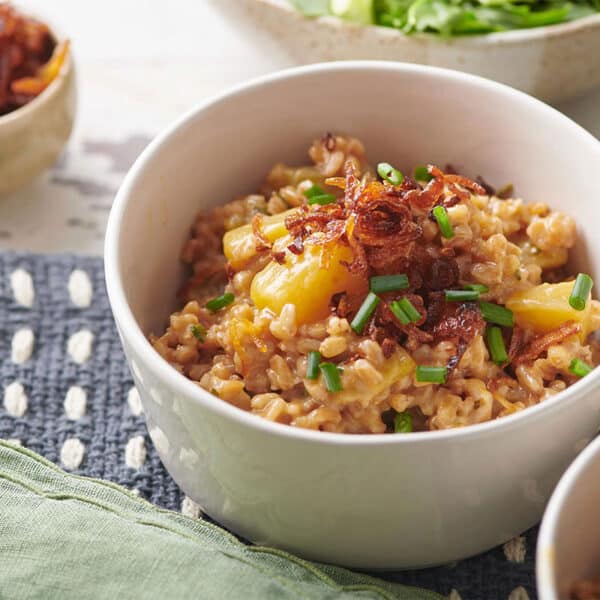
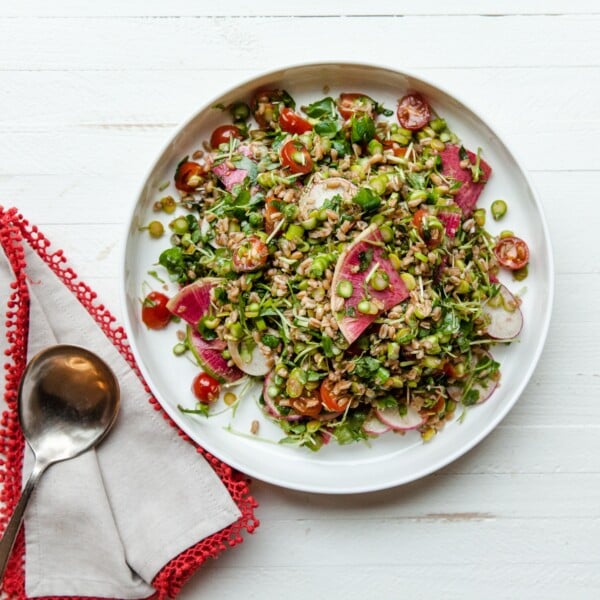
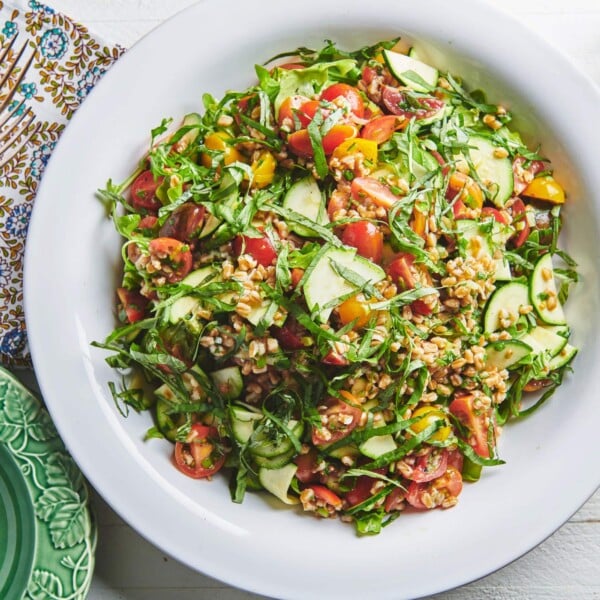
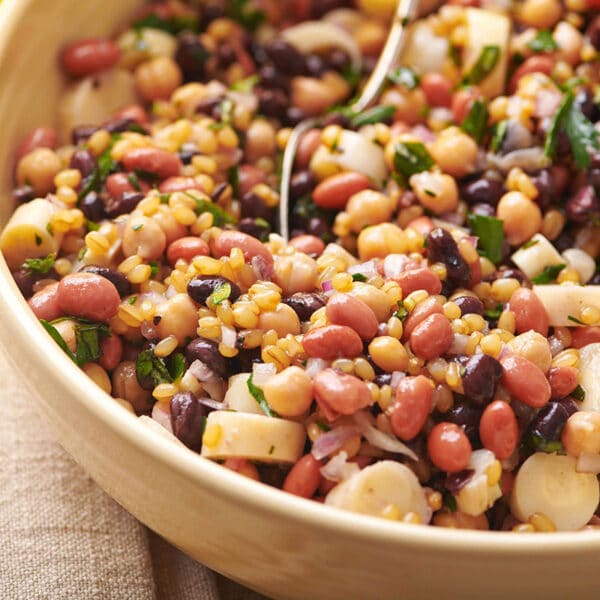









Absolutely love this recipe….so flavorful! Farro has become my favorite ❤️!
How do I eat it for breakfast ? Can I eat it with milk like I eat my oat meal? I’m just starting to experience eating grains and for adding protein .
You could! maybe a little honey or brown sugar, and maybe a pinch of cinnamon? it’s much denser than oatmeal, so a little will be pretty filling.
If the farro is toasted, do I still need to rinse it?
Thank you!
I am not 100% sure, but I would err on the side of rinsing!
Hi, just read your steps to cook Farro and a excited to try. I do have a question though. Step 4 says if you’re using it in a salad to spread it out on a baking sheet to ‘cook’ to prevent it from getting mushy. Do you mean spread it out to ‘cool’? Thank you!
I surely did mean cool, thank you!